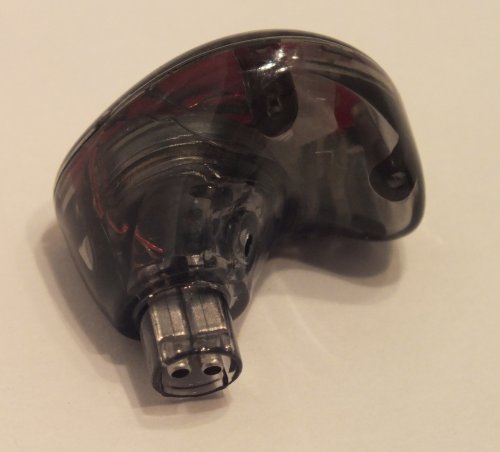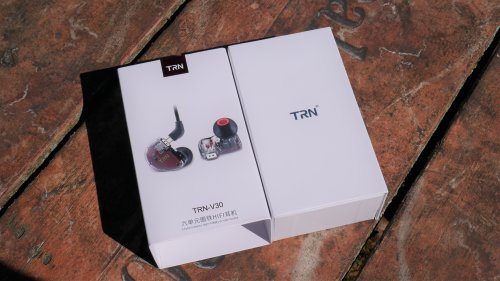TRN V30 (25 USD)

Purchase Link (Linsoul): https://www.linsoul.com/products/trn-v30
Purchase Link (Aliexpress): https://www.aliexpress.com/item/32987668319.html
I am getting such a strong vibe that the point of V30 was for it to cost about 30 USD, but right now the only price I can find is 25 USD, which makes its existence a funny irony for me. Now, when it comes to the product itself, I have mixed feelings about it. On one hand, it shows very well why I generally don't like IEMs below the 50 USD price point, it has a plasticky build quality, it is not very well built either, and it has a very polite, but lacking in details sonic quality.
On the other hand, it costs just 25 USD, and if you don't have more, and if you want a polite tuning, V30 is simply great, because TRN made sure there was something to fill in that gap.
I made a Youtube Video about it as well, which you can find here:




The package for V30 is pretty much what you would expect from a 25 USD IEM, the IEM, a cable, and three sets of Silicone tips. I mean, this is really okay, and I don't mind the contents of the package being a bit lacking. V30 makes it up by its really low price.
In terms of build quality, this is as much of a plasticky IEM, as you could get. It looks a bit more like a toy, with the electronics on the visible side, than an IEM.
TRN probably went ahead and copied the concept from KZ and their AS and ZS series, where the driver crossover was visible, but in the process, TRN forgot to check whether the design made as much sense for an IEM that had such a simplistic crossover, and one where the configuration is a triple driver, a trio of a dynamic driver, and two Balanced Armatures. At any rate, V30 looks a bit like a toy, but does it sound like one, or does it actually sound respectable for the price point?

Well, before that, we should talk about comfort, which is fair. The shell is not too large, and I felt it was a bit smaller than the shell of the KZ AS10 series, at least placing them side by side. This being said, V30 also isolates fairly well from the outside, with about 20 dB of passive noise isolation. The cable, though, is just terrible. Feels like one of the cheapest, least trusty cable I've seen, and I can see why they are priced at just 25 USD and not more, and it is easy to see where TRN cut corners with V30.
I'm enthusiastic to see detachable cables at 25 USD, and not just detachable cables, but 2-Pin ones, but it is much cheaper to replace the entire IEM than to replace the cable if it broke, and well, if the cable of V30 broke, I would probably try a different IEM at this price point, to learn and to experiment. Still, if the cable broke within warranty, Linsoul would help you get a replacement, and makes the whole IEM easier to service, so it is a nice addition.
The sonic signature is a basic V-shaped signature, but with a very polite overall tuning, with very little bass detail, but not very little bass amount necessarily. The midbass is very recessed, and makes it feel as if male voices are super recessed. The upper midrange then is not quite as recessed, so most music ends up sounding a bit shouty. This being said, a very polite and rolled off treble makes it up for an... interesting experience. I feel that most of the signature is self explanatory, minus the treble, which I feel the need to explain a bit.

The treble sounds like it is lifted above the midrange at first, but that is actually the upper midrange and very early lower treble, because after it, there is a very steep roll-off, after which there is nothing. If you ever imagined a sound with almost no detail, no clarity, no air, and with a confined soundstage, this is pretty much it. It is not that I mind it quite that much, but for rock, metal, pop, it does not work so well. I can see the signature working well for Jazz and downtempo, maybe some Electronic, some Trap and some lower energy music, but for energetic music, it is just a bit boring.

Purchase Link (Linsoul): https://www.linsoul.com/products/trn-v30
Purchase Link (Aliexpress): https://www.aliexpress.com/item/32987668319.html
I am getting such a strong vibe that the point of V30 was for it to cost about 30 USD, but right now the only price I can find is 25 USD, which makes its existence a funny irony for me. Now, when it comes to the product itself, I have mixed feelings about it. On one hand, it shows very well why I generally don't like IEMs below the 50 USD price point, it has a plasticky build quality, it is not very well built either, and it has a very polite, but lacking in details sonic quality.
On the other hand, it costs just 25 USD, and if you don't have more, and if you want a polite tuning, V30 is simply great, because TRN made sure there was something to fill in that gap.
I made a Youtube Video about it as well, which you can find here:




The package for V30 is pretty much what you would expect from a 25 USD IEM, the IEM, a cable, and three sets of Silicone tips. I mean, this is really okay, and I don't mind the contents of the package being a bit lacking. V30 makes it up by its really low price.
In terms of build quality, this is as much of a plasticky IEM, as you could get. It looks a bit more like a toy, with the electronics on the visible side, than an IEM.
TRN probably went ahead and copied the concept from KZ and their AS and ZS series, where the driver crossover was visible, but in the process, TRN forgot to check whether the design made as much sense for an IEM that had such a simplistic crossover, and one where the configuration is a triple driver, a trio of a dynamic driver, and two Balanced Armatures. At any rate, V30 looks a bit like a toy, but does it sound like one, or does it actually sound respectable for the price point?

Well, before that, we should talk about comfort, which is fair. The shell is not too large, and I felt it was a bit smaller than the shell of the KZ AS10 series, at least placing them side by side. This being said, V30 also isolates fairly well from the outside, with about 20 dB of passive noise isolation. The cable, though, is just terrible. Feels like one of the cheapest, least trusty cable I've seen, and I can see why they are priced at just 25 USD and not more, and it is easy to see where TRN cut corners with V30.
I'm enthusiastic to see detachable cables at 25 USD, and not just detachable cables, but 2-Pin ones, but it is much cheaper to replace the entire IEM than to replace the cable if it broke, and well, if the cable of V30 broke, I would probably try a different IEM at this price point, to learn and to experiment. Still, if the cable broke within warranty, Linsoul would help you get a replacement, and makes the whole IEM easier to service, so it is a nice addition.
The sonic signature is a basic V-shaped signature, but with a very polite overall tuning, with very little bass detail, but not very little bass amount necessarily. The midbass is very recessed, and makes it feel as if male voices are super recessed. The upper midrange then is not quite as recessed, so most music ends up sounding a bit shouty. This being said, a very polite and rolled off treble makes it up for an... interesting experience. I feel that most of the signature is self explanatory, minus the treble, which I feel the need to explain a bit.

The treble sounds like it is lifted above the midrange at first, but that is actually the upper midrange and very early lower treble, because after it, there is a very steep roll-off, after which there is nothing. If you ever imagined a sound with almost no detail, no clarity, no air, and with a confined soundstage, this is pretty much it. It is not that I mind it quite that much, but for rock, metal, pop, it does not work so well. I can see the signature working well for Jazz and downtempo, maybe some Electronic, some Trap and some lower energy music, but for energetic music, it is just a bit boring.


























